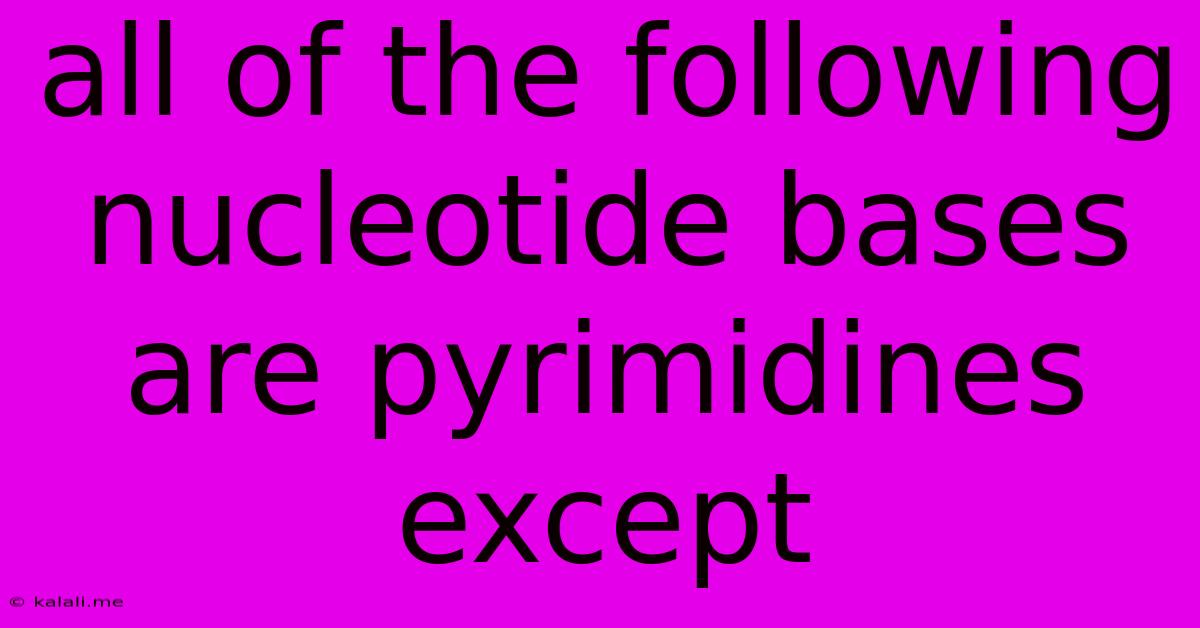All Of The Following Nucleotide Bases Are Pyrimidines Except
Kalali
Jun 14, 2025 · 3 min read

Table of Contents
All of the Following Nucleotide Bases are Pyrimidines Except: Understanding Purines and Pyrimidines
Understanding the fundamental building blocks of DNA and RNA is crucial for comprehending the complexities of genetics and molecular biology. This article clarifies the distinction between purines and pyrimidines, focusing specifically on identifying which of a given set of bases is not a pyrimidine. We'll explore the structural differences and the implications of this distinction for DNA and RNA function.
What are Nucleotide Bases?
Nucleotides are the fundamental units of nucleic acids like DNA and RNA. Each nucleotide consists of three components: a sugar molecule (ribose in RNA, deoxyribose in DNA), a phosphate group, and a nitrogenous base. These nitrogenous bases are categorized into two groups: purines and pyrimidines. The difference in their structure plays a critical role in how they pair up within the DNA double helix and RNA structures.
Purines vs. Pyrimidines: The Structural Difference
The key difference lies in their ring structure. Pyrimidines are characterized by a single six-membered ring structure containing nitrogen atoms. Purines, on the other hand, have a larger structure consisting of a six-membered ring fused to a five-membered ring, both containing nitrogen atoms.
The Key Players: Adenine, Guanine, Cytosine, Thymine, and Uracil
The five main nitrogenous bases found in DNA and RNA are:
- Adenine (A): A purine base found in both DNA and RNA.
- Guanine (G): A purine base found in both DNA and RNA.
- Cytosine (C): A pyrimidine base found in both DNA and RNA.
- Thymine (T): A pyrimidine base found only in DNA.
- Uracil (U): A pyrimidine base found only in RNA.
Identifying the Non-Pyrimidine
Given a list of nucleotide bases, identifying the one that isn't a pyrimidine is straightforward. Since adenine and guanine are purines, any list containing either of them will have a non-pyrimidine base. For example:
- Question: All of the following nucleotide bases are pyrimidines EXCEPT: Cytosine, Thymine, Adenine, Uracil.
- Answer: Adenine.
Why is the Distinction Important?
The difference between purines and pyrimidines is crucial for several reasons:
- Base Pairing: The specific pairing of bases (A with T or U, and G with C) is due to the complementary shapes and hydrogen bonding capabilities of purines and pyrimidines. This precise pairing is essential for DNA replication and transcription.
- DNA Structure: The double helix structure of DNA relies on the consistent pairing of one purine with one pyrimidine (A-T and G-C). This ensures uniform width throughout the helix.
- Genetic Code: The sequence of these bases forms the genetic code, determining the amino acid sequence of proteins and ultimately the characteristics of an organism.
Conclusion:
Understanding the difference between purines and pyrimidines is fundamental to grasping the principles of molecular biology and genetics. By recognizing the characteristic structures of these bases, you can easily identify which bases are pyrimidines and which are not, a key concept for comprehending the intricate workings of DNA and RNA. Remember, the key to correctly answering "All of the following nucleotide bases are pyrimidines except..." is to identify the purines in the list.
Latest Posts
Latest Posts
-
How To Find Minor Of Matrix
Jun 14, 2025
-
What Is The Most Destructive Seismic Wave
Jun 14, 2025
-
How Is Amplitude Related To Energy
Jun 14, 2025
-
What Is The Meaning Of The Underlined Idiom
Jun 14, 2025
-
Difference Between Article And Journal Title
Jun 14, 2025
Related Post
Thank you for visiting our website which covers about All Of The Following Nucleotide Bases Are Pyrimidines Except . We hope the information provided has been useful to you. Feel free to contact us if you have any questions or need further assistance. See you next time and don't miss to bookmark.